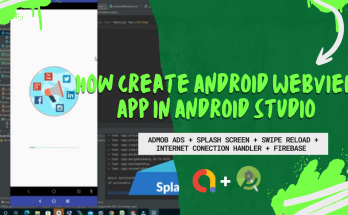Traccar is an open-source GPS tracking system that supports more than 170 GPS protocols and more than 1500 models of GPS tracking devices. Customizing the Traccar Android app allows businesses to rebrand and tailor the application to their specific needs, enhancing their brand identity and providing a more cohesive user experience. This article will guide you through the process of custom branding the Traccar Android app using Android Studio.
Prerequisites
Before starting, ensure you have the following:
- Android Studio installed on your machine.
- Basic knowledge of Android development.
- The Traccar Android app source code from the Traccar GitHub repository.
Step-by-Step Guide
1. Setting Up the Project
- Clone the Repository:
git clone https://github.com/traccar/traccar-client-android.git- Open the Project in Android Studio:
Launch Android Studio and selectOpen an existing Android Studio project, then navigate to the cloned repository.
2. Change the Package Name
The package name is a unique identifier for your app on the Google Play Store. To change it:
- Navigate to
AndroidManifest.xmland change thepackageattribute. - Refactor the package name in your project files:
- Right-click on the
com.traccar.clientpackage. - Select
Refactor>Rename. - Choose
Rename Allto update the package name throughout the project.
3. Modify App Name and Icons
- Change App Name:
- Open
res/values/strings.xml. - Modify the
<string name="app_name">Traccar</string>to your desired app name. - Replace App Icons:
- Prepare your new icons following Android’s icon design guidelines.
- Replace the existing icons in
res/mipmapandres/drawabledirectories with your custom icons. Ensure you provide icons for all required densities (mdpi, hdpi, xhdpi, xxhdpi, xxxhdpi).
4. Customize Colors and Themes
- Update Colors:
- Open
res/values/colors.xml. - Replace the default colors with your brand colors.
- Modify Themes:
- Open
res/values/themes.xml(orthemes.xmlfor different API levels). - Update the theme colors to match your brand.
5. Update UI Components
To customize the user interface:
- Navigate through the XML layout files in
res/layoutand update them as needed to align with your brand’s aesthetics. - Modify any drawable resources, such as backgrounds and icons, to reflect your brand’s visual identity.
6. Adjust Strings and Texts
- Open
res/values/strings.xml. - Review and update the strings to match the tone and language style of your brand.
7. Integrate Custom Features (Optional)
If you want to add new features or modify existing ones:
- Review the Java/Kotlin code in the
srcdirectory. - Implement your custom features by modifying or extending the existing codebase.
8. Testing Your Custom App
- Run on Emulator:
Use Android Studio’s built-in emulator to test your changes. - Run on Physical Device:
Connect a physical device via USB and run the app to ensure it functions correctly on actual hardware.
9. Build and Release
- Generate Signed APK:
- Navigate to
Build>Generate Signed Bundle / APK. - Follow the prompts to create a signed APK for distribution.
- Upload to Google Play Store:
- Ensure you have a developer account.
- Follow the Google Play Store guidelines to publish your app.
Step-by-Step Guide to Integrate Firebase into Your Custom-Branded Traccar Android App
1. Create a Firebase Project
- Go to the Firebase Console: Firebase Console.
- Add a New Project: Click on
Add project, enter your project name, and follow the setup wizard. - Register Your App:
- Select the Android icon to add an Android app.
- Enter your app’s package name (e.g.,
com.yourcompany.yourappname). - Follow the prompts to download the
google-services.jsonfile.
2. Add google-services.json to Your Project
- Download the
google-services.jsonfile from the Firebase Console. - Place this file in the
appdirectory of your Android project.
3. Modify Your build.gradle Files
Update the build.gradle files to include Firebase dependencies.
Project-level build.gradle (usually located at the root of your project):groovyCopy codebuildscript { repositories { google() mavenCentral() } dependencies { classpath 'com.android.tools.build:gradle:7.3.0' classpath 'com.google.gms:google-services:4.3.10' // Add this line } } allprojects { repositories { google() mavenCentral() } }App-level build.gradle (inside the app directory):groovyCopy codeapply plugin: 'com.android.application' apply plugin: 'com.google.gms.google-services' // Add this line android { compileSdkVersion 33 defaultConfig { applicationId "com.yourcompany.yourappname" minSdkVersion 16 targetSdkVersion 33 versionCode 1 versionName "1.0" } buildTypes { release { signingConfig signingConfigs.debug // Replace this with your release signing config minifyEnabled false proguardFiles getDefaultProguardFile('proguard-android-optimize.txt'), 'proguard-rules.pro' } } } dependencies { implementation 'com.google.firebase:firebase-analytics:21.0.0' // Add this line // Add other Firebase dependencies as needed }4. Sync the Project with Gradle Files
Click Sync Now in the notification bar that appears after modifying the build.gradle files to sync the project with the new configuration.
5. Initialize Firebase in Your Application
To initialize Firebase, modify your MainActivity or your application class.
In your MainActivity:javaCopy codeimport android.os.Bundle; import com.google.firebase.analytics.FirebaseAnalytics; import androidx.appcompat.app.AppCompatActivity; public class MainActivity extends AppCompatActivity { private FirebaseAnalytics mFirebaseAnalytics; @Override protected void onCreate(Bundle savedInstanceState) { super.onCreate(savedInstanceState); setContentView(R.layout.activity_main); // Initialize Firebase Analytics mFirebaseAnalytics = FirebaseAnalytics.getInstance(this); } }Step-by-Step Guide to Configure Gradle for Google Play Release
1. Open the Project in Android Studio
Ensure your project is open in Android Studio. Locate the build.gradle file in the app module of your project.
2. Modify the build.gradle File
Open the build.gradle file and make the following modifications:
To release your custom-branded Traccar Android app on the Google Play Store, you need to modify the build.gradle file appropriately. Below is the detailed step-by-step guide including the code you mentioned for adding the release build configuration in the Gradle file.
Step-by-Step Guide to Configure Gradle for Google Play Release
1. Open the Project in Android Studio
Ensure your project is open in Android Studio. Locate the build.gradle file in the app module of your project.
2. Modify the build.gradle File
Open the build.gradle file and make the following modifications:
..............
compileOptions {
sourceCompatibility = JavaVersion.VERSION_17
targetCompatibility = JavaVersion.VERSION_17
}
kotlinOptions {
jvmTarget = JavaVersion.VERSION_17.toString()
}
}
Add this ...!
buildTypes {
release {
signingConfig signingConfigs.debug
}
}
}
repositories {
google()
mavenCentral()
}
3. Create a Signing Configuration
For production releases, you should not use the debug signing configuration. Instead, create a new signing configuration with a release key.
- Create signed key
- Save the generated
release-key.jksfile in a secure location and make a note of the keystore password, key alias, and key password. - Add the signing configuration to the
build.gradlefile:
4. Sync the Project with Gradle Files
Click on Sync Now in the notification bar that appears after modifying the build.gradle file to sync the project with the new configuration.
5. Generate the Signed APK
- Go to
Build>Generate Signed Bundle / APK. - Select
APK. - Choose the
releasebuild type. - Follow the prompts to use your release key and generate the signed APK.
6. Upload to Google Play Store
- Sign in to your Google Play Console.
- Create a new application or select an existing one.
- Upload the signed APK under the
Release managementsection. - Complete the necessary information such as app description, screenshots, and categorization.
- Submit the app for review.
Conclusion
By following these steps, you can configure your Gradle build file to prepare your custom-branded Traccar Android app for release on the Google Play Store. Remember to use a proper release key for signing your APK and not the debug key used in the development phase. This ensures the security and authenticity of your application in the Play Store.


